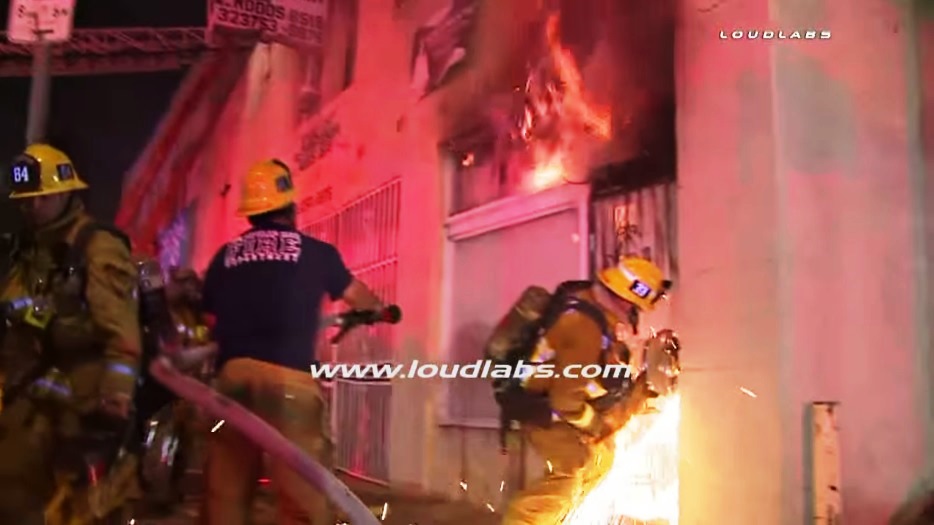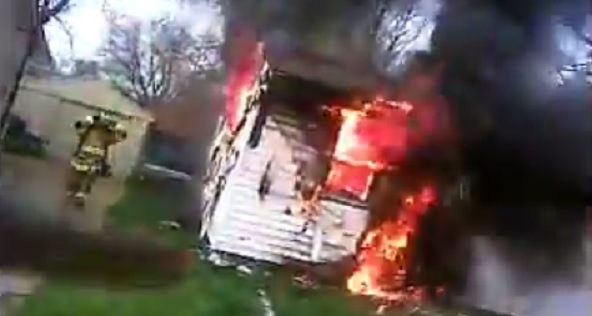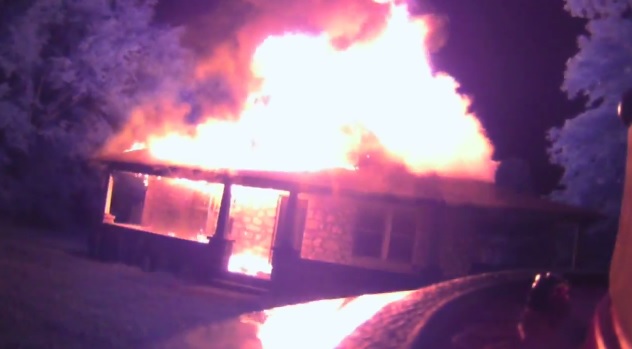White House on fire: Film of DC firefighters handling West Wing fire in 1929
ADDITIONAL INFORMATION ABOUT WHITE HOUSE FIRE
Veteran fire buff and long time member of the Friendship Fire Association (FFA) Vito Maggiolo saw the 1929 film and provided this very interesting story from the fire at The White House:
Andy Horn, who was to become a long time member of FFA when it came into existence, was a fire buff back then along with his brother. They buffed the job and became aware of the discomfort of the firefighters working in the very cold weather.
Their solution was to slip away to a nearby speakeasy and buy a number of small flasks of hooch. They then passed them throughthe White House fence to the grateful firefighters. Quite a different sort of canteen operation, and try doing that today!
FIRE AT THE WHITE HOUSE
Christmas Eve 1929 and the West Wing of The White House was burning. Luckily firefighters in the District of Columbia weren’t out on crime patrol or transporting injured and sick people to the hospital on fire trucks. Firefighters responded to 1600 Pennsylvania Avenue and faced a significant fire that would go down in the history books.
It wasn’t a good year for President Herbert Hoover or the country. The fire came about two months after Black Tuesday and the crash on Wall Street that preceded the Great Depression. The fire broke out as President Hoover was hosting the White House Christmas party.
Above is film of that fire uploaded today (Friday) to the YouTube channel of CriticalPast. Below, is video of the repairs to The White House and part of the account of that fire written by the late Col. Robert Debs Heinl, Jr., USMC, who was also a fire buff. Col. Heinl witnessed the fire as a 13-year-old boy. The website Arlington Fire Journal published Col. Heinl’s complete account in 2012:
At Fire Alarm Headquarters there came a single tap on the “joker” as the box was pulled. There was a pause, then the box number rang in. After another pause, a second round of bell strokes commenced.
Box 157—the White House !” sang out the telegrapher. The switchboard man swiftly cranked in the uptown home of Chief Engineer George S. Watson. Seconds later, in all Washington fire stations, polished brass gongs chimed: 1-5-7 …1-5-7 …1-5-7.
As the big new 1927 Seagrave pumper of Engine 1, the first-due engine at the White House, roared through the front gates, Captain Edward O’Connor could already see fire behind the small attic windows of the West Wing. So could Central Battalion Chief C. W. Gill as he sped westward along Pennsylvania Avenue. With Engine i’s line stretched from the pumper to the front door of the Executive Offices, Chief Gill led the hosemen inside the smoke-charged building. Amid the heat and fumes, Gill called for Rescue Squad 1, in those days the only firemen with “smoke helmets” (respirator masks), to lead the way up the attic stairs. As they advanced the hose line into the attic, the atmosphere grew thick and heavy. Suddenly a rush of hot gas, a blast of heat, and a fireball of flame whooshed into the stair well, blowing Chief Gill and most of his crew down to the main floor.
Because of back draft, the fireman’s most dangerous foe, superheated fumes were ignited when fresh air from the stairway reached the fire in the attic. As Gill staggered to his feet amid the injured—four men were down—his first action was to order a second alarm. Then he reorganized his people, called for water, and advanced upward again behind Engine 1’s stream.
While the first-due companies in front of the White House had their hands full with what was evidently a “working fire,” Engines 16 and 23, responding at the rear, had problems of a different kind. Although they could see the fire plainly enough, the massive iron gates on the sides and rear of the White House grounds were locked and barred.
This contingency was one that Chief Engineer Watson had long ago foreseen. As a result of his urgings, master keys to the White House gates had been issued to the captain of each company due on a first alarm from Box 157. What Chief Watson could not have foreseen, however, was what now happened. With Keystone Cop supersecurity the Secret Service had had the locks changed but failed to notify the Fire Department. Thus when Engines 16 and 23 reached the east and west rear gates, they, together with Truck 3, whose 85-foot aerial ladder could reach the burning roof, had to wait in the street until puffing White House policemen could get the keys and run to open them.
When the back draft blew Chief Gill down the attic stairs, the time was approximately 8:15.∗ A minute later Deputy Chief Engineer P. W. Nicholson rolled in at the rear, took one look at Truck 3’s ladder being cranked up and at the fire in the windows, and at 8:17 ordered a third alarm. With Chief Gill’s second alarm at 8:16, this meant that eight additional engine companies, two more truck (that is, hook-and-ladder) companies, and the water tower were converging on the White House from all over central Washington as fast as the snorting new motorized pieces could travel.
Like Sheridan at Cedar Creek, Chief Watson was also approaching the scene at high speed, but in his red Cadillac touring car, not on horseback. “I was notified by Fire Alarm Headquarters,” he reported, “that the White House box was being received and immediately left my home and proceeded to the White House as rapidly as traffic congestion would permit.” This is something of an understatement. With isinglass side curtains whistling, Watson’s rig covered the thirty-five-block stretch from his house to the President’s through downtown evening traffic in eight minutes flat.
Reaching the site of the fire at 8:18, Chief Watson gave orders for deployment of the incoming second- and third-alarm companies; then, seeing flames already breaking through the roof and skylights, he ordered a fourth alarm. This would bring four more engine companies, call in off-shift men to activate reserve pieces, and fully mobilize Washington’s then and to this day highly efficient Fire Department. With the fifth and final alarm, sounded at the fire’s height at 9:24 P.M., roughly two thirds of the department was concentrated in the Lafayette Square area, some pumpers taking water from hydrants from as far as five blocks away.What faced Chief Watson was a government office fire of a stubborn type only too familiar to D.C. firemen: a cramped space overflowing with paper, with virtually no accesses or vents, heavily charged with fire and heat. It has happened many times before and since 1929 in offices of the Commerce, Agriculture, and Treasury departments, as well as in that great pyramid of paperwork, the Pentagon. It was also the sixth fire in the history of 1600 Pennsylvania Avenue. The first, in 1814 (arson committed by British soldiers), was followed in 1866 by a serious fire in the conservatory (President Hoover’s vantage point in 1929), then by two small blazes in Woodrow Wilson’s time, and by one kitchen fire during the days of Calvin Coolidge.
The firemen’s first tactics were to get onto the roof of the West Wing and play streams of water into the White House skylights. They soon discovered, however, that most of the skylights gave onto partitioned air shafts going directly down to the main floor. Not much water could reach the seat of the fire this way, but it did get elsewhere. White House reporters, braving the smoke to salvage files in the press room (not to mention the new Webster’s dictionary and stand they had recently chipped in for), enountered water over their high-topped shoes throughout the main floor. In the basement, working by kerosene lantern, Rice stayed by his switchboard until, with icy water knee deep, his boss ordered him to shut down. Six men from Engine 16 and Truck 3, working to save the President’s office proper, were flattened when the ceiling, weakened by water and fire, crashed down. Miraculously, four were unhurt, but the crystal chandelier took its toll on two. Outside, the streets and walls and firemen were sheeted with ice.









